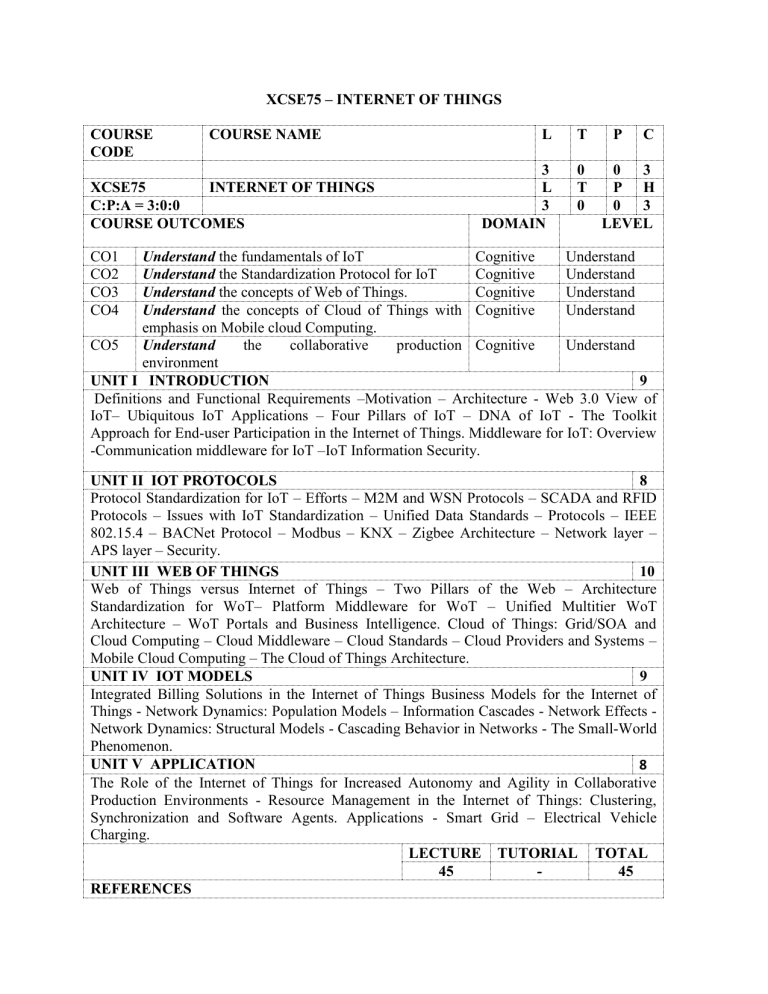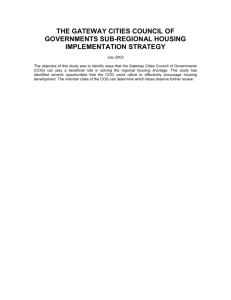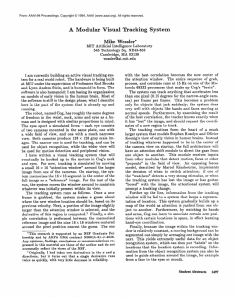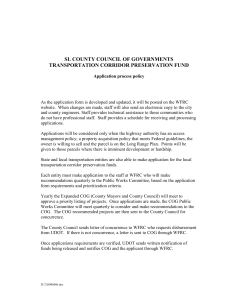IoT Course Syllabus: Fundamentals, Protocols, and Applications
advertisement

XCSE75 – INTERNET OF THINGS COURSE CODE COURSE NAME XCSE75 INTERNET OF THINGS C:P:A = 3:0:0 COURSE OUTCOMES L T 3 L 3 DOMAIN 0 T 0 P C 0 3 P H 0 3 LEVEL CO1 CO2 CO3 CO4 Understand the fundamentals of IoT Cognitive Understand Understand the Standardization Protocol for IoT Cognitive Understand Understand the concepts of Web of Things. Cognitive Understand Understand the concepts of Cloud of Things with Cognitive Understand emphasis on Mobile cloud Computing. CO5 Understand the collaborative production Cognitive Understand environment UNIT I INTRODUCTION 9 Definitions and Functional Requirements –Motivation – Architecture - Web 3.0 View of IoT– Ubiquitous IoT Applications – Four Pillars of IoT – DNA of IoT - The Toolkit Approach for End-user Participation in the Internet of Things. Middleware for IoT: Overview -Communication middleware for IoT –IoT Information Security. UNIT II IOT PROTOCOLS 8 Protocol Standardization for IoT – Efforts – M2M and WSN Protocols – SCADA and RFID Protocols – Issues with IoT Standardization – Unified Data Standards – Protocols – IEEE 802.15.4 – BACNet Protocol – Modbus – KNX – Zigbee Architecture – Network layer – APS layer – Security. UNIT III WEB OF THINGS 10 Web of Things versus Internet of Things – Two Pillars of the Web – Architecture Standardization for WoT– Platform Middleware for WoT – Unified Multitier WoT Architecture – WoT Portals and Business Intelligence. Cloud of Things: Grid/SOA and Cloud Computing – Cloud Middleware – Cloud Standards – Cloud Providers and Systems – Mobile Cloud Computing – The Cloud of Things Architecture. UNIT IV IOT MODELS 9 Integrated Billing Solutions in the Internet of Things Business Models for the Internet of Things - Network Dynamics: Population Models – Information Cascades - Network Effects Network Dynamics: Structural Models - Cascading Behavior in Networks - The Small-World Phenomenon. UNIT V APPLICATION 8 The Role of the Internet of Things for Increased Autonomy and Agility in Collaborative Production Environments - Resource Management in the Internet of Things: Clustering, Synchronization and Software Agents. Applications - Smart Grid – Electrical Vehicle Charging. LECTURE TUTORIAL TOTAL 45 45 REFERENCES 1. The Internet of Things in the Cloud: A Middleware Perspective - Honbo Zhou – CRC Press – 2012. 2. Architecting the Internet of Things - Dieter Uckelmann; Mark Harrison; Florian Michahelles- (Eds.) – Springer – 2011 3. Networks, Crowds, and Markets: Reasoning About a Highly Connected World - David Easley and Jon Kleinberg, Cambridge University Press - 2010 4. The Internet of Things: Applications to the Smart Grid and Building Automation by Olivier Hersent, Omar Elloumi and David Boswarthick - Wiley -2012 5. Olivier Hersent, David Boswarthick, Omar Elloumi , “The Internet of Things – Key applications and Protocols”, Wiley, 2012. Table 1. Mapping of COs with POs: CO1 PO 1 1 PO 2 3 PO 3 0 PO 4 0 PO 5 0 PO 6 0 PO 7 0 PO8 PO9 CO2 1 CO3 0 PO 10 0 PO 11 0 PO 12 0 0 3 1 0 0 0 0 1 3 2 1 1 0 CO4 1 3 2 2 0 CO5 1 3 2 2 4 12 0 3 PSO 1 1 PSO 2 0 0 0 0 0 0 2 0 0 0 0 0 0 0 3 0 0 0 0 0 0 0 0 1 0 1 0 1 0 1 1 0 1 3 0 1 0 0 0 0 0 0 0 6 0 PO1 PO2 PO3 PO4 PO5 PO6 PO7 PO8 PO9 PO10 PO11 PO12 PSO PSO 1 2 Original 4 12 0 3 1 6 0 0 0 0 0 0 0 0 Scaled to 0,1,2,3 scale 1 3 0 1 1 0 0 0 0 0 Performance Indicators P1 1.1 will be able to understand the fundamental concepts of IoT 1.1.1 will know the need for IoT 1.1.2 will understand the Web 3.0 1.1.3 will understand different layers of IoT 0 0 2 0 P2 P3 P4 P5 2.1 Will understand the Standards & Protocols used for IoT 2.1.1 Will understand the BACNet protocol 2.1.2 will understand Network and APS layer 3.1 Will understand the Architecture and standardization for WoT 3.1.1 Will understand Middleware platform for WoT 3.1.2 Will understand the Cloud middleware 3.1.3 Will understand Cloud of Things Architecture 4.1 Will understand billing solutions in IoT business model 4.1.1 Will understand the network dynamics 4.1.2 Will understand the cascading behavior in networks 5.1 Will understand the collaborative production environment 5.1.1 Will understand the resource management 5.1.2 Will understand clustering and synchronization Table 2: Assessment Template S.No. Task Marks 1 CA 1 (Class Test- 1) CA 2 (Class Test- 2) CA3 CA 4End Semeste r Total 15 15 15 15 20 50 20 50 2.5 10 100 100 20 2 3 4 Weigh CO tage 1 % 7.5 CO 2 CO 3 CO 4 CO 5 7.5 Weigh tage Form ative Weig htage Sum mativ e 50 7.5 7.5 2.5 10 2.5 10 2.5 10 10 10 20 20 20 20 50 50 50 Table 3: COs Versus Real Marks S.No. 1 2 3 4 Assessment Type CA 1 (Class TestDescriptive 60% + 2 Marks 20% + MCQ 20%) CA 2 (Class TestDescriptive 60% + 2 Marks 20% + MCQ 20%) CA3 (3) tools CA 4- End Semester Pattern (MCQ – 10% + 2 Marks 10% Descriptive 80%) Total Marks Weigh tage% F 50 15 F 50 15 S 100 CO1 24 CO2 CO3 CO4 CO5 26 24 26 2.5 20 2.5 2.5 2.5 50 20 20 20 20 10 20 100 Table 4. Question Paper versus COs Mapping - CA 1 CA1 MCQ10x1 = 10 Type Compulsory Compulsory 2 marks – 5 x2=10 15 marks – 2x15 = 30 Total 50 Either or CO1 CO2 Q.No. Mark Domain Level Q.No. Mark Domain Level 1 2 3 1 1 1 Cog,R Cog,R Cog,R 7 8 9 1 1 1 Cog,R Cog,R Cog,R 4 1 Cog,R 10 1 Cog,R 5 1 Cog,R 6 1 Cog,R Q.No. Mark Domain Level Q.No. Mark Domain Level 11 12 2 2 Cog,U Cog,U 13 14 15 2 2 2 Cog,U Cog,U Cog,U. Q.No. Mark Domain Level Q.No. Mark Domain Level 16.a 8 Cog,U 18.a 7 Cog,U. 16.b 7 Cog,U 18.b 8 Cog,U. 17.a 8 Cog,U 19.a 7 Cog,U. 17.b 7 Cog,U 19.b 8 Cog,U. 25 25 Table 5 Question Paper versus COs Mapping - CA 2 CA2 MCQ10x1 = 10 Type Compulsory Compulsory 2 marks – 5 x2=10 15 marks – 2x15 = 30 Either or CO3 CO4 Q.No. Mark Domain Level Q.No. Mark Domain Level 1 2 3 1 1 1 Cog,R Cog,R Cog,R 7 8 9 1 1 1 Cog,R Cog,R Cog,R 4 1 Cog,R 10 1 Cog,R 5 1 Cog,R 6 1 Cog,R Q.No. Mark Domain Level Q.No. Mark Domain Level 11 12 2 2 Cog,U Cog,U 13 14 15 2 2 2 Cog,U Cog,U Cog,U. Q.No. Mark Domain Level Q.No. Mark Domain Level 16.a 8 Cog,U 18.a 7 Cog,U. 16.b 7 Cog,U 18.b 8 Cog, U. 17.a 8 Cog,U 19.a 7 Cog, U. 17.b 7 Cog,U 19.b 8 Cog, U. Total 50 25 25 Table 6: Mapping Course Outcome with Assessment for CA3 (20%) CA 3 Components Assignment Review Paper Product Design Total Marks % CO1 CO2 5 5 10 20 2.5 2.5 2.5 2.5 CO3 CO4 2.5 2.5 2.5 2.5 CO5 10 10 Table 7 CA 3 Rubrics – 20 MARKS Tool 1: Assignment Excellent Criterion 100 Very Good 75 Weightage: 5% Domain s Good Fair 50 25 Needs Improv ement CO s Mar ks Levels 10 Submission 20% Submitted Submitted on nth day on Submitted on (n+1)th day Submitted Submitt on (n+2) ed on day (n+3)da y after 20 20 ( n-1)th day Given almost all contents Given key points Given basic contents Given only a portion of contents Complet ely off track Neat and correct usage of grammar, no spelling mistakes, appropriate diagrams used Neat and correct usage of grammar, no spelling mistakes, few diagrams used Few writing with grammar and spelling mistakes ,no diagrams used Careless writing with grammar and spelling mistakes Below standard Coherence 20% Coherent and completely organized coherent and reasonably organized fairly coherent some confusion and vagueness missed the point complet ely References 20% (Text books, magazines, e-references, journals, ejournals, NPTEL) Sources are cited and are used critically Sources are cited and some are used critically Some sources are missing Sources are not cited Did not include Content Clarity 20% Presentation 20% 20 1& 2 Cog(U) 20 20 Tool 2: Review Paper (5% Weightage) Criterion Excellent Very Good 75% 100% Good Fair 50% 25% Needs Improvement CO Ma rks Dom ain / Level 50 Cog. – 0% Understanding, Clarity in presentation 50% References 50% Understands the concepts clearly and presented all the points neatly without grammatical and spelling mistakes. Understands the concepts clearly but presented some the points neatly without grammatical and spelling mistakes. Understands the concepts clearly and presented some the points with some grammatical and spelling mistakes. Understands a few concepts clearly and presented some the points with many grammatical and spelling mistakes. Misunderstood the concepts and gave wrong answer All latest 10 papers referred and cited in review properly All 10 papers referred and cited in review properly Not all 10 papers No reference papers referred but given referred and not cited in cited in review review properly properly 3&4 Und. 50 Cog. Und Tool 3: Product Design Excellent 100 Very Good 75 Weightage: 10% Good 50 Satisfacto ry 25 CO Ma rks Task Feature Identification (30%) Technical design (40%) References (10%) Communication (20%) All features of the product have been identified correctly Most of the features of the product have been identified correctly Few features have been identified correctly One or two features only identified Given details of design for all the features Design for most of the features given Design for few of the features given Design for one or two features given References quoted properly Most references given properly Few references given One or two references given Good Language, body language and eye to eye contact Good Language Adequate language skill Pronunciat ion is not clear 30 40 CO5 10 20 Dom ains Leve ls Table 8 CA 4 Mapping – 100 MARKS CA4 MCQ 10x1= 10 2 Marks 5 x2=10 15 Marks 4x15=60 Typ e Co mpu lsor y 100 CO2 Q.N o. M ar ks Doma ins / Level s 1 1 2 M ar ks Cog-R 4 1 1 Cog-R 5 1 3 1 Cog-R 6 1 Co mpu lsor y 11 2 CogU Eith er or 16 a.i 8 16 a.ii 7 16 b. i 8 16 b. ii. 7 2 17. a.i. 8 CogU 17. a.ii. 7 Cog- 17 b. i 8 17 b.ii. 7 20 a 5 CogU 20 12 M ar ks CogU U Co mpu lsor y Q. No. CO3 Q. No . Eith er or 20 Marks 1x20=20 CO1 Dom ains/ Leve ls Cog- 13 U Cog- 18 U U 7 8 7 Cog Cog Cog U CogU 22 Cog U b.ii 20 C05 Q.N o. M ar ks Dom ains/ Leve ls Q. No. M ar ks Dom ains/ Leve ls 7 1 Cog -R 8 1 9 1 10 1 Cog R CogR CogR 14 2 CogU 15 2 CogU 20 c 10 CogApp Cog -U U b.i Cog- 18 Do mai ns/ Lev els Cog -R Cog -R Cog -R U a.ii Cog- 18 U 8 a.i Cog- 18 U 2 CO4 19 a.i 8 19 b.i 7 19 a.ii 8 19 b.ii 7 20 b 5 Cog U Cog U Cog U Cog U 21 Cog Und 17 COURSE PLAN Unit Topic Subtopic Teaching Method Teaching Aids / Venue Targeted learning domain No. of Hrs. Relation to COs 1.1 Definitions and Functional Chalk and Requirements Talk BB/ Class Room Cog.-R,U 1 1 1.2 Motivation – Architecture - PPT Cog.- R,U 1 1 1.3 Web 3.0 View of IoT– PPT Cog.- R,U 1 1 1.4 Ubiquitous IoT Applications PPT Cog.- R,U 1 1 1.5 Four Pillars of IoT PPT Cog.- R,U 1 1 1.6 DNA of IoT PPT Cog.- R,U 1 1 1.7 The Toolkit Approach for End- user Participation in the Internet of Things PPT Cog.- R,U 1 1 1.8 Middleware for IoT: Overview -–Communication middleware for IoT PPT Cog.- R,U 1 1 Cog.- R,U 1 1 1 INTRODUCTION Slip test using Google Form 9 TOTAL 2 2.1 Protocol Standardization for IoT – Efforts PPT Cog.- R,U 1 2 M2M and WSN Protocols PPT Cog.- R,U 1 2 SCADA and RFID Protocols PPT Cog.- R,U 1 2 Issues with IoT Standardization - Unified Data Standards PPT Cog.- R,U 1 2 Protocols – IEEE 802.15.4 PPT Cog.- R,U 1 2 BACNet Protocol PPT Cog.- R,U 1 2 Modbus, KNX PPT Cog.- R,U 1 2 Zigbee Architecture, Network layer PPT Cog.- R,U 1 2 APS layer, Security. PPT Cog.- R,U 1 2 Assignment Announcement TOTAL 3 3.1 Web of Things versus Internet of Things, Two Pillars of the Web 9 PPT Cog.- R,U 1 3 Architecture Standardization for WoT, Platform Middleware for WoT PPT Cog.- R,U 1 3 Unified Multitier WoT Architecture PPT Cog.- R,U 1 3 WoT Portals and Business Intelligence PPT Cog.- R,U 1 3 Cloud of Things: Grid/SOA and Cloud Computing PPT Cog.- R,U 1 3 Cloud Middleware PPT Cog.- R,U 1 3 Cloud Standards PPT Cog.- R,U 1 3 Cloud Providers and Systems PPT Cog.- R,U 1 3 Mobile Cloud Computing PPT Cog.- R,U 1 3 The Cloud of Things Architecture PPT Cog.- R,U 1 Assignment Submission 10 TOTAL 4 4.1 Integrated Billing Solutions in the Internet of Things: Introduction, Cost involved at various levels, benefits Framework of billing solution PPT Cog.- R,U 1 4 PPT Cog.- R,U 1 4 Business Models for the Internet of Things: Business model, Business model & innovation Business model for various applications Network Dynamics: Population Models PPT Cog.- R,U 1 4 PPT Cog.- R,U 1 4 PPT Cog.- R,U 1 4 5 Information Cascades PPT Cog.- R,U 1 4 Network Effects PPT Cog.- R,U 1 4 Network Dynamics: Structural Models: Cascading Behavior in Networks The Small-World Phenomenon Review Paper Submission Product design Announcement TOTAL PPT Cog.- R,U 1 4 PPT Cog.- R,U 1 4 5.1 The Role of the Internet of Things for Increased Autonomy and Agility in Collaborative Production Environments, Introduction, Challenges of Networked Enterprises PPT Cog.- R,U 1 5 Fundamental Concepts of Agility and Autonomy, Enabling Autonomy and Agility by the Internet of Things PPT Cog.- R,U 1 5 Technical Requirement for satisfying new demands in production logistics PPT Cog.- R,U 1 5 Agents for behavior of objects, Application Automotive TaillightsIntelligent product PPT Cog.- R,U 1 5 Challenges by Developing IOT, Resource Management in the Internet of Things: Clustering, Synchronization and Software Agents:Clustering, Software Agents PPT Cog.- R,U, 1 5 9 Assumptions and Definitions, Clustering for scalability, Software Agents for Object Representation PPT Cog.- R,U 1 5 Data synchronation, Requirements and challenges PPT Cog.- R,U 1 5 Applications -Smart Grid, Electrical Vehicle Charging PPT Cog.- R,U 1 5 Product design submission PPT Cog.- R,U 1 5 TOTAL 8



